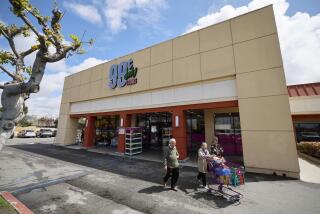Discounters May Get ‘Tougher’ as Department Stores Strike Back
- Share via
OKLAHOMA CITY — Department stores are striking back at off-price retailers that have been “kicking them in the teeth,” but Mike Hammond says the discounters will only get tougher.
“As department stores . . . change their ways of retailing, the off-pricing people will too, and they’ll just get tougher,” said Hammond, general manager of Tapp Development Co., a developer of the off-price Outlet Malls of America.
Tapp, headquartered here, recently sold five if its six OMA properties for $52 million to Krupp Co. of Boston to finance expansion in Texas, Colorado, Arizona, New Mexico and Louisiana.
Around for Decades
“All of our malls have been extremely successful,” said Hammond. “This (off pricing) is the new evolution in retailing that’s sweeping America.”
Cut-rate retailers have been around for decades in the form of bargain basements and factory outlets. But the new breed of off-pricers has adopted sophisticated purchasing and marketing techniques and carved out a sizable niche in the retail industry.
Beginning around 1979, off-pricing began to assert itself, posting annual growth rates topping 20%. By 1983, off-price retailers--which market brand-name products discounted 20% to 80% off the same merchandise sold in department stores--had estimated gross sales of almost $7 billion, 5.6% of the U.S. apparel and footwear market.
But some industry experts say off-pricers may be sailing into rough waters as the huge department stores retaliate with their own price cutting, sales at the peak of purchasing seasons and “sharper” buying practices.
“The department stores are putting the squeeze on the off-pricers,” said Charles Veysey, merchandising consultant to the National Retail Merchants Assn. in New York.
The NRMA represents companies with a total of 45,000 retail stores, including off-price retailers.
Getting Kicked
“The regular retailers are beginning to sit up and take note that these off-price retailers are kicking them in the teeth,” Hammond agreed, “and they’re not going to take it lying down.”
Carol Sanger, spokeswoman for Federated Department Stores, headquartered in Cincinnati, said, “The entire retail environment has within the last year become more competitive.”
She ascribed it not to off-pricing but to “increased and expanded competition.” Federated, she said, is “not strictly a traditional retailer” but is into mass-merchandising, with its cut-rate Filene’s Basement.
Sanger said the growth of off-pricing “seems to have reached a peak” and Veysey agreed the industry is “leveling off.”
“That’s a sure sign of maturity,” Veysey said. “It’s more like a saturation of the market.”
The weak off-pricers are beginning to feel the crunch, he said.
“A lot of them are going to fall by the wayside, especially the ones who are coming into the business right now,” Veysey said. “I think the industry is going through a shake-out now.”
Fighting Back
One way department stores--retailers that carry full-priced brand-name goods--are fighting back is to move more into their own private-label goods. That keeps an off-price retailer down the street from carrying the same items under the same brands.
“The department stores can control the price on those,” Veysey said.
Hammond said Tapp is determined to be a winner in the struggle between off-pricers and department stores.
Other investors also apparently are confident of the future of off-pricing.
“There are developers building outlet malls all over the U.S.,” Hammond said. “There are probably 200 outlet malls in the United States now.”
“It’s not a problem,” Sanger said, “because department stores offer more than just price.” She cited customer service, selection and depth of inventory, store ambiance and highly refined marketing strategy.
Still she said shoppers in this era of off-pricing are more aware of bargains.
More to Read
Inside the business of entertainment
The Wide Shot brings you news, analysis and insights on everything from streaming wars to production — and what it all means for the future.
You may occasionally receive promotional content from the Los Angeles Times.










